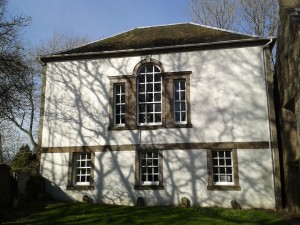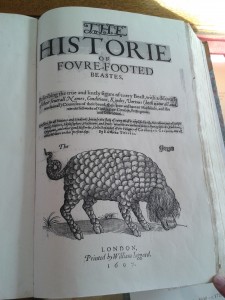by Katie Halsey
On 21st March a small group of doctoral students (“fit audience, though few”, as Milton would have said) visited Innerpeffray Library for the third of “The 21st-Century Book Historian” doctoral training events. It was a beautiful Spring day – so warm in fact, that we were able to have a picnic outside in the Library’s beautiful grounds before commencing the more serious parts of the day. Special thanks to Maxine Branagh, who brought along some delicious dairy- and gluten-free brownies for us all to share.
 The day began with a welcome from Lara Haggerty, Keeper of Books at the library. Lara spoke very interestingly about the library’s history and aims, and then went on to discuss its current role as a Historic Library museum. Innerpeffray Library is Scotland’s oldest public lending library, established in 1680 by David Drummond, 3rd Lord Madertie. Books from the library were made available to the local community from at least 1747 (although this may have been as early as 1680) to 1968. Lara emphasized the importance of the founder’s Will, in which he asked that his books be used “For the benefit of ALL”. The library began as a collection of the founder’s books, but expanded over the generations as successive Trustees of the library increased the book collection.
The day began with a welcome from Lara Haggerty, Keeper of Books at the library. Lara spoke very interestingly about the library’s history and aims, and then went on to discuss its current role as a Historic Library museum. Innerpeffray Library is Scotland’s oldest public lending library, established in 1680 by David Drummond, 3rd Lord Madertie. Books from the library were made available to the local community from at least 1747 (although this may have been as early as 1680) to 1968. Lara emphasized the importance of the founder’s Will, in which he asked that his books be used “For the benefit of ALL”. The library began as a collection of the founder’s books, but expanded over the generations as successive Trustees of the library increased the book collection.
From the eighteenth century to the late twentieth century, borrowers came to Innerpeffray to read from its collections, and they came from a wide variety of social backgrounds, from local laird to shepherd and schoolchild. In conjunction with the school, also set up by Lord Madertie, the library functioned as part of an important Scottish Enlightenment project described in Lord Madertie’s will as being “for the improvement and education of the population particularly the young students.”
 The library no longer functions as a lending library (although scholars, researchers and readers are always welcome to use its collections onsite), as it is now a Historic Library museum. Lara interestingly discussed the challenges that the library faces in attracting visitors and raising money, and then offered us the opportunity to browse the collections. We were all delighted to be allowed to get our hands on some extremely rare and valuable books! We spent an hour browsing, and, helped by the library’s knowledgeable volunteer guides, Marion and Bill, everyone found something to interest them. Lucy focused on the library’s excellent collection of early and rare Bibles, and Alia was also pleased to find a particular Bible that she had not been able to see elsewhere. Maxine (pictured) and Lauren were riveted by the library’s Borrowers’ Registers, and spent most of their time putting their palaeography skills to work on these fascinating MS documents. Louisa discovered a number of delightful titbits in the library’s full run of the Scots Magazine, including an article ‘Observations of the last Solar Eclipse’ (of 1737) – a timely discovery given that we had also experienced a solar eclipse the previous day (20th March 2015) – while Patti enjoyed a number of the library’s beautiful illustrated books, focusing on the exhibition cases in the main room.
The library no longer functions as a lending library (although scholars, researchers and readers are always welcome to use its collections onsite), as it is now a Historic Library museum. Lara interestingly discussed the challenges that the library faces in attracting visitors and raising money, and then offered us the opportunity to browse the collections. We were all delighted to be allowed to get our hands on some extremely rare and valuable books! We spent an hour browsing, and, helped by the library’s knowledgeable volunteer guides, Marion and Bill, everyone found something to interest them. Lucy focused on the library’s excellent collection of early and rare Bibles, and Alia was also pleased to find a particular Bible that she had not been able to see elsewhere. Maxine (pictured) and Lauren were riveted by the library’s Borrowers’ Registers, and spent most of their time putting their palaeography skills to work on these fascinating MS documents. Louisa discovered a number of delightful titbits in the library’s full run of the Scots Magazine, including an article ‘Observations of the last Solar Eclipse’ (of 1737) – a timely discovery given that we had also experienced a solar eclipse the previous day (20th March 2015) – while Patti enjoyed a number of the library’s beautiful illustrated books, focusing on the exhibition cases in the main room.
After a brief coffee break and breath of fresh air, we returned for a Q&A discussion with Lara about working in the Heritage sector, and how the skills learned during a PhD might be useful in a job like hers. Volunteers Marion and Bill also kindly answered questions about their role and their motivations for getting involved with the library. This led on to a brief talk by me (Katie Halsey) on the relationship between the Impact Agenda and doctoral research, in which I discussed some examples of research questions based on Innerpeffray Library’s borrowers’ registers, and how these research questions had led to sometimes unexpected opportunities for outreach activities for the library. For example, from our research findings about the distances borrowers had travelled to borrow the books in the eighteenth century, the library had organised a “Recreate a Journey Taken by a Historic Borrower” event, when groups of local walkers and horse-riders had enjoyed walking or riding the historic paths and tracks around the area. This had generated a great deal of publicity for the library in the local press, which brought more visitors to the library. We reflected together on the possible benefits (and challenges) of the relationship between researchers and heritage organisations.
 The students then spent the final session reflecting on the day and what they could all take away from it to apply to their own research practices. One group commented that being able to handle the books makes Innerpeffray much more accessible than the National Library of Scotland or the British Library, and they appreciated the intimacy of the experience with the books. They also enjoyed having the experience of browsing and exploring the shelves, which allowed them to find interesting things, such as relevant inscriptions, through serendipity. Students had found it helpful to reflect on visitor experiences in a place like Innerpeffray, and had thought about how different constituencies of visitors needed different things. In addition, they had found it useful to think about the ways in which a small rural library was connected to the wider world, both in its historical incarnation and in the present. Other students commented on the library’s strong ties with the local community, and about the sense of connection with borrowers in the past. Without exception, students commented on the sense of calm and peace in the library’s environment.
The students then spent the final session reflecting on the day and what they could all take away from it to apply to their own research practices. One group commented that being able to handle the books makes Innerpeffray much more accessible than the National Library of Scotland or the British Library, and they appreciated the intimacy of the experience with the books. They also enjoyed having the experience of browsing and exploring the shelves, which allowed them to find interesting things, such as relevant inscriptions, through serendipity. Students had found it helpful to reflect on visitor experiences in a place like Innerpeffray, and had thought about how different constituencies of visitors needed different things. In addition, they had found it useful to think about the ways in which a small rural library was connected to the wider world, both in its historical incarnation and in the present. Other students commented on the library’s strong ties with the local community, and about the sense of connection with borrowers in the past. Without exception, students commented on the sense of calm and peace in the library’s environment.
The day ended with a walk to nearby Innerpeffray Castle.
A big thank you to Lara, Marion and Bill for being such wonderful hosts. We very much look forward to returning soon.

Comments are closed.